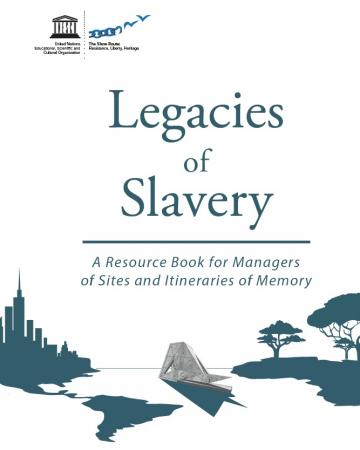Legacies of Slavery: A Resource Book for Managers of Sites and Itineraries of Memory

“Long isolated and limited to a few famous sites of slavery and the slave trade (such as the Island of Gorée in Senegal, the Ghana forts and the Citadelle Henry Christophe in Haiti), historic towns (such as Salvador in Brazil and Cartagena in Colombia) and remains (such as plantations in the Caribbean), initiatives aimed at establishing this tangible heritage in national memorial landscapes have significantly increased, diversified and gained momentum over the last 20 years or so. This memorial heritage is often endangered, however, by ignorance of its historical value, negligence, a lack of means for managing it or even financial greed aroused by its value on the real-estate market.
Countries have adopted different strategies to preserve their memorial sites and monuments: inscriptions on the World Heritage List, which involves specific obligations; listings as national cultural heritage, which guarantee a certain level of protection; and the creation of memory routes promoted in cultural tours by communities and/or local authorities. Some combine these different strategies simultaneously.
Site managers and authorities are therefore constantly facing challenges triggered by tourism development projects. Those challenges faced by managers of sites or routes linked to the history of the slave trade and slavery are specific to the very nature of the historical subject and include, for example, the possible loss of historical landmarks or their fall into oblivion; the gradual disappearance of this memorial heritage; and the extreme sensitivity of the subject. Managers should be aware of the risk of certain pitfalls in approaching this theme. Important choices must be made to avoid a reification of the slave trade and slavery as a tourist product, along with other pitfalls linked to economic exploitation and speculation. It is important to prevent programmes of commercial exploitation and mass tourism, such as hotel areas and/or tourist recreation parks of a speculative nature.
The third challenge in the preservation and enhancement of memorial heritage linked to the history of the slave trade and slavery is the need to involve communities in reclaiming these sites. The commitment of the communities involved, especially by women and young people, is essential to the sound management of the site or route. It will enable them to benefit from the development and will provide them with economic and cultural tools of self-determination and identity.
This methodological guide intends to address these concerns by analysing the experiences of professionals working in the field, decision-makers involved in the development of public policy and researchers who have considered and discussed the topic. Its main objective is to offer assistance to the different stakeholders involved in memory policies and the management of heritage linked to the slave trade and slavery in three main ways:
1. Providing a frame of reference to government authorities in charge of formulating development policies for historical heritage to support their efforts to identify, safeguard and develop tangible sites and monuments, as well as anti-slavery resistance and abolition movements.
2. Providing managers with a methodological tool to strengthen their capacity to address the different issues they are facing.
3. Encouraging experience-sharing and partnerships between managers of memorial sites and monuments to stimulate the creation of regional and international memory networks and routes.
This guide offers examples of best practices, identifies new approaches, defines guidelines, provides recommendations and promotes the building of networks. In short, it aims to boost the effectiveness of the management, development and promotion of historical and memorial sites and routes linked to the slave trade and slavery in different regions of the world. In addition to addressing these needs specific to the operational development of memory tourism, this guide aims to raise awareness of the pitfalls and risks linked to promoting this specific memorial heritage, especially when tours highlight the wealth of buildings formerly owned by slave masters rather than the sweat and blood of the slaves who built them. It is important to take into account all the tangible and intangible legacies of the slave trade and slavery: the slave factories, the fortifications, the homes of the slave masters, but also the places where physical cruelty took place, the resistance sites and the achievements of slaves, considering that the symbolic, memorial and social value of such heritage does not always match the key criteria in terms of business, aesthetics and tourism”
